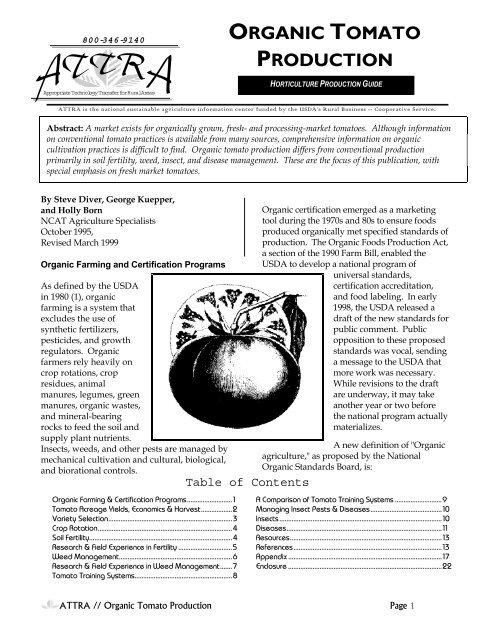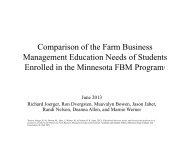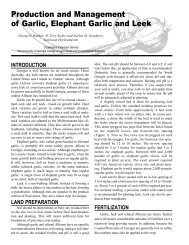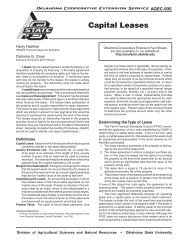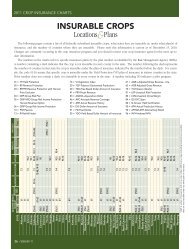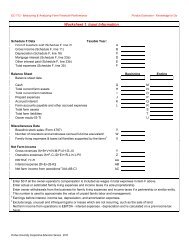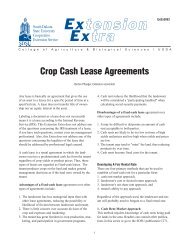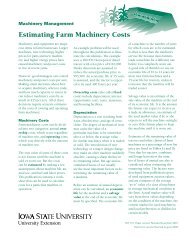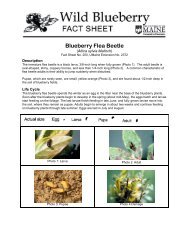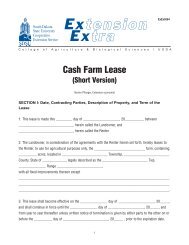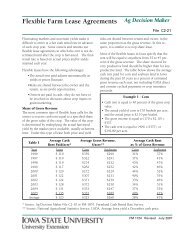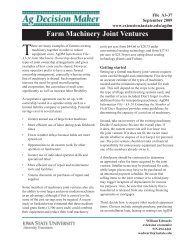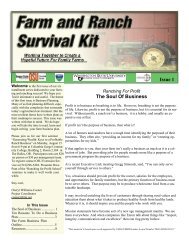Organic Tomato Production - National Ag Risk Education Library
Organic Tomato Production - National Ag Risk Education Library
Organic Tomato Production - National Ag Risk Education Library
Create successful ePaper yourself
Turn your PDF publications into a flip-book with our unique Google optimized e-Paper software.
800-346-9140<br />
Appropriate Technology Transfer for RuralAreas<br />
ORGANIC TOMATO<br />
PRODUCTION<br />
HORTICULTURE PRODUCTION GUIDE<br />
ATTRA is the national sustainable agriculture information center funded by the USDA’s Rural Business -- Cooperative Service.<br />
Abstract: A market exists for organically grown, fresh- and processing-market tomatoes. Although information<br />
on conventional tomato practices is available from many sources, comprehensive information on organic<br />
cultivation practices is difficult to find. <strong>Organic</strong> tomato production differs from conventional production<br />
primarily in soil fertility, weed, insect, and disease management. These are the focus of this publication, with<br />
special emphasis on fresh market tomatoes.<br />
By Steve Diver, George Kuepper,<br />
and Holly Born<br />
NCAT <strong>Ag</strong>riculture Specialists<br />
October 1995,<br />
Revised March 1999<br />
<strong>Organic</strong> Farming and Certification Programs<br />
As defined by the USDA<br />
in 1980 (1), organic<br />
farming is a system that<br />
excludes the use of<br />
synthetic fertilizers,<br />
pesticides, and growth<br />
regulators. <strong>Organic</strong><br />
farmers rely heavily on<br />
crop rotations, crop<br />
residues, animal<br />
manures, legumes, green<br />
manures, organic wastes,<br />
and mineral-bearing<br />
rocks to feed the soil and<br />
supply plant nutrients.<br />
Insects, weeds, and other pests are managed by<br />
mechanical cultivation and cultural, biological,<br />
and biorational controls.<br />
<strong>Organic</strong> Farming & Certification Programs..........................1<br />
<strong>Tomato</strong> Acreage Yields, Economics & Harvest..................2<br />
Variety Selection.......................................................................3<br />
Crop Rotation.............................................................................4<br />
Soil Fertility..................................................................................4<br />
Research & Field Experience in Fertility ...............................5<br />
Weed Management.................................................................6<br />
Research & Field Experience in Weed Management.......7<br />
<strong>Tomato</strong> Training Systems........................................................8<br />
<strong>Organic</strong> certification emerged as a marketing<br />
tool during the 1970s and 80s to ensure foods<br />
produced organically met specified standards of<br />
production. The <strong>Organic</strong> Foods <strong>Production</strong> Act,<br />
a section of the 1990 Farm Bill, enabled the<br />
USDA to develop a national program of<br />
universal standards,<br />
certification accreditation,<br />
and food labeling. In early<br />
1998, the USDA released a<br />
draft of the new standards for<br />
public comment. Public<br />
opposition to these proposed<br />
standards was vocal, sending<br />
a message to the USDA that<br />
more work was necessary.<br />
While revisions to the draft<br />
are underway, it may take<br />
another year or two before<br />
the national program actually<br />
materializes.<br />
A new definition of "<strong>Organic</strong><br />
agriculture," as proposed by the <strong>National</strong><br />
<strong>Organic</strong> Standards Board, is:<br />
Table of Contents<br />
A Comparison of <strong>Tomato</strong> Training Systems ...........................9<br />
Managing Insect Pests & Diseases .........................................10<br />
Insects .............................................................................................10<br />
Diseases.........................................................................................11<br />
Resources.......................................................................................13<br />
References.....................................................................................13<br />
Appendix ........................................................................................17<br />
Enclosure ........................................................................................22<br />
ATTRA // <strong>Organic</strong> <strong>Tomato</strong> <strong>Production</strong> Page 1
<strong>Organic</strong> agriculture is an ecological<br />
production management system that<br />
promotes and enhances biodiversity,<br />
biological cycles and soil biological activity.<br />
It is based on minimal use of off-farm inputs<br />
and management practices that restore,<br />
maintain and enhance ecological harmony.<br />
<strong>Organic</strong> is a labeling term which denotes<br />
products produced under the requirements of<br />
the <strong>Organic</strong> Foods <strong>Production</strong> Act.<br />
The primary goal of <strong>Organic</strong> agriculture is<br />
to optimize the health and productivity of<br />
interdependent communities of soil life,<br />
plants, animals and people. The principal<br />
guidelines for organic production are to use<br />
materials and practices that enhance the<br />
ecological balance of natural systems and<br />
that integrate the parts of the farming<br />
system into an ecological whole. <strong>Organic</strong><br />
agriculture practices cannot ensure that<br />
products are completely free of residues;<br />
however, methods are used to minimize<br />
pollution from the air, soil and water.<br />
<strong>Organic</strong> food handlers, processors and<br />
retailers adhere to standards that maintain<br />
the integrity of <strong>Organic</strong> agriculture<br />
products.<br />
Growers choose organic methods for a variety of<br />
reasons. One of the attractions of organic<br />
produce is that it sometimes brings a 10−30%<br />
premium in the marketplace. As organicallygrown<br />
produce becomes commonplace, however,<br />
these premiums may be the exception rather than<br />
the rule, and motivation beyond market<br />
premiums should be considered. Incentives may<br />
include the possibility of reduced input costs,<br />
improved farm safety, reduced environmental<br />
impact, and a better-functioning agroecosystem.<br />
In addition to organic production, IPM<br />
certification has emerged as a marketing tool for<br />
growers for whom organic production is<br />
impractical or otherwise unsuitable. Though<br />
such programs do not restrict pesticide use,<br />
produce is raised within a comprehensive IPM<br />
framework, and total pesticide usage is often<br />
reduced. For example, Responsible Choice is an<br />
IPM-label for apples raised in a growers’<br />
cooperative in Washington State.<br />
The Cooperative Extension Service at the<br />
University of Massachusetts developed IPM<br />
standards for tomatoes. The standards are based<br />
on a set of best management practices that<br />
emphasize sound nutrient management, crop<br />
rotation, legume cover cropping, sanitation<br />
procedures, field scouting, pesticide record<br />
keeping, and so on. Growers earn a set number<br />
of points for each practice utilized in their<br />
production program. To be certified, each field<br />
must accumulate 311 out of a possible 445 IPM<br />
Practice Points⎯70% of the total (2).<br />
<strong>Tomato</strong> Acreages, Yields, Economics, and<br />
Harvest<br />
The tomato is one of the most commonly grown<br />
fresh market vegetables. Yet, since tomatoes are<br />
both high yielding and labor intensive, 1/4-acre,<br />
1/2-acre, and 1-acre production units are common<br />
with market gardeners. In Massachusetts, for<br />
example, there are approximately 500 acres of<br />
tomatoes, and approximately 500 vegetable farms.<br />
Since some of the larger farms produce 10−15 acres<br />
of tomatoes, quite a few farms grow less than one<br />
acre (3).<br />
<strong>Tomato</strong> yields of 650 to 850 boxes (30 pounds<br />
each) per acre are common in the South Central<br />
U.S. (e.g., Oklahoma) (4). This is equivalent to<br />
19,000 to 25,000 pounds or about 10 to 13 tons per<br />
acre. Comparable fresh market yields of 23,000 to<br />
27,000 pounds per acre are listed in Knott's<br />
Handbook for Vegetable Growers (5). In 1990, the<br />
average fresh market tomato yield nationwide<br />
was 25,100 pounds per acre (6).<br />
<strong>Production</strong> and marketing costs for intensively<br />
cultured tomatoes can be over $4,000 per acre<br />
with an expected gross return of $4,000 to $8,000<br />
per acre (7). Gross returns of $18,000 are not<br />
uncommon (8). One organic farmer in New<br />
Jersey netted $10,000 an acre, with 10 acres in<br />
production (9).<br />
Efficient harvesting, handling, and marketing<br />
techniques are extremely important in the<br />
production of this highly perishable crop.<br />
Harvesting tomatoes is very labor intensive. One<br />
source (10) estimates 350 hours for each staked<br />
acre. For storage and shipping, fruit can first be<br />
ATTRA // <strong>Organic</strong> <strong>Tomato</strong> <strong>Production</strong> Page 2
picked at the "breaker" stage of maturity, when the<br />
blossom end turns pink. Post-harvest temperature<br />
management is critical to maintain quality.<br />
<strong>Tomato</strong>es may become damaged when stored<br />
below 55°F. The optimum temperature range for<br />
longest shelf life is between 55°F and 70°F (5).<br />
In general, the tomato market fluctuates with the<br />
growing season, starting high and dropping as<br />
the summer season progresses. That is why<br />
plasticulture and hoop house production ⎯<br />
techniques which increase earliness or extend the<br />
season ⎯ have become popular.<br />
Figure 1. 1997 Seasonal Price Variation, <strong>Organic</strong> Fresh-Market <strong>Tomato</strong>es*<br />
1.80<br />
1.60<br />
1.40<br />
1.20<br />
1.00<br />
0.80<br />
Lo/lb<br />
Hi/lb<br />
Mean/lb<br />
0.60<br />
0.40<br />
0.20<br />
0.00<br />
JAN FEB MAR APR MAY JUNE JUL AUG SEP OCT NOV DEC<br />
* Prices are average of each month’s weekly prices from the <strong>Organic</strong> Food and Business News<br />
Weekly Fax Bulletin. Note that prices are farmgate and represent only West and East Coast<br />
markets.<br />
Variety Selection<br />
Factors influencing selection of tomato varieties<br />
include market demands, disease resistance,<br />
suitability to production systems, and regional<br />
adaptability.<br />
Market demands: Wholesale markets that<br />
involve handling and packaging of the fruit<br />
require firm varieties suitable for shipping. This<br />
is less critical in farmers' markets, roadside<br />
stands, and U-pick sales. In these cases, local<br />
consumer preference dictates which varieties to<br />
choose and may provide opportunities for<br />
specialty tomatoes (e.g., yellow, pink, low-acid,<br />
cherry, pear-shaped, and heirloom varieties).<br />
Disease resistance: Diseases are the Achilles heel<br />
of organic tomato production. The use of<br />
resistant and tolerant varieties can give the<br />
farmer a "leg up" on pest management. Consider<br />
varieties such as the Mountain series developed<br />
ATTRA // <strong>Organic</strong> <strong>Tomato</strong> <strong>Production</strong> Page 3
at North Carolina State University (e.g.,<br />
Mountain Pride, Supreme, Gold, Fresh, and<br />
Belle), which are tolerant to early blight.<br />
Suitability to production systems: <strong>Tomato</strong>es have<br />
growth habits ranging from determinate (bush)<br />
to indeterminate (vining). Growth habit affects<br />
staking methods, pruning, length of harvest<br />
season, and other aspects of management.<br />
Regional adaptability: Cooperative Extension<br />
Service publications and commercial seed<br />
catalogs provide information on varieties<br />
adapted to local conditions.<br />
Crop Rotation<br />
Crop rotation is a major component of organic<br />
farming, affecting both soil conditions and pest<br />
cycles. <strong>Tomato</strong>es belong to the nightshade family<br />
(Solanaceae), which includes potatoes, eggplant,<br />
peppers, and garden huckleberry. Rotation to<br />
non-solanaceous crops for three years is usually<br />
recommended to avoid pest problems common to<br />
this group of vegetables (11).<br />
For market gardeners and farmers with limited<br />
growing space, long rotations may be impractical.<br />
In these instances, soil building practices such as<br />
green manuring and composting ⎯ practices that<br />
support abundant soil microflora ⎯ are doubly<br />
important to create natural disease suppressive<br />
conditions.<br />
Sod crops preceding tomatoes ⎯ such as grass<br />
pasture and small grains crops ⎯ often result in<br />
heavy cutworm and/or wireworm damage to<br />
tomatoes. When soil building crops such as these<br />
are grown in rotation to increase soil structure<br />
and organic matter, they should be plowed down<br />
several months in advance of planting.<br />
Soil Fertility<br />
The foundation of organic farming is a<br />
microbially active soil enriched with organic<br />
matter and a balanced mineral diet. Humus<br />
building practices and additions of rock minerals<br />
not only supply plant nutrients, but increase<br />
tolerance to insects and diseases, help control<br />
weeds, retain soil moisture, and finally, ensure<br />
produce quality.<br />
The organic fertility system revolves around a<br />
combination of practices such as crop rotation;<br />
forage legumes, cover crops, and green manures;<br />
livestock manures (preferably composted); lime,<br />
rock phosphate, and other rock minerals; and<br />
lastly, supplemental organic fertilizers.<br />
On soils managed biologically for several years,<br />
tomatoes yield well from legume and compost<br />
treatments alone. While 5−10 tons/acre/year is a<br />
typical rate of compost application for vegetables,<br />
organic growers in New Jersey have been scaling<br />
back on compost rates for tomatoes, especially on<br />
established fields. Rates as low as 1−2<br />
tons/acre/year are performing well.<br />
Applications of well-rotted barnyard manures at<br />
10−15 tons/acre/year have been recommended for<br />
tomato production. These are typically soilincorporated<br />
in fall or early spring before planting.<br />
Raw manures are restricted in organic certification.<br />
They should be fall-applied, preferably to cover<br />
crops, well in advance of the crop.<br />
"Hot manures" such as poultry litter are often<br />
limited to 4 tons/acre in the Ozark region; and<br />
less than 1 ton/acre in spring, well-incorporated<br />
at least two weeks prior to transplanting.<br />
Research from Alabama suggests higher rates of<br />
fall-applied poultry litter (9−18 tons/acre) can<br />
also yield good results (12). Poultry litter may be<br />
restricted in some organic certification programs.<br />
Soils with no history of organic management will<br />
probably need additional fertilization. Fertilizer<br />
can be incorporated during field preparation and<br />
bedding operations, or banded to the side of the<br />
row at planting.<br />
Fresh market tomatoes require about 75 to 100<br />
pounds of nitrogen (N) per acre. Most, if not all,<br />
can be supplied by legumes in rotation; composts<br />
or manures can fill in the balance. Some farmers<br />
provide additional supplemental nitrogen at<br />
transplanting; a mixture of animal meal byproducts,<br />
rock phosphate, and kelp meal is<br />
commonly used.<br />
ATTRA // <strong>Organic</strong> <strong>Tomato</strong> <strong>Production</strong> Page 4
If reliance is primarily on supplemental<br />
fertilizers, about 50 pounds of actual nitrogen<br />
should be applied pre-plant, and the remainder<br />
side-dressed when fruits are about nickel-size.<br />
Old tomato publications recommended drilling<br />
or banding cottonseed meal, blood meal, or<br />
similar medium-to-fast acting organics at the<br />
time of planting (13).<br />
<strong>Tomato</strong>es need moderate to high levels of<br />
phosphorus (P) and potassium (K). On deficient<br />
soils, most needs can be met by advance<br />
applications of rock powders such as rock<br />
phosphate, colloidal phosphate, untreated<br />
(mined) potassium sulfate, and sulfate of potashmagnesia.<br />
Supplementary P and K may be<br />
added as indicated by soil test results compared<br />
to guidelines provided by Cooperative Extension;<br />
for example, see Table 1 “Plant Nutrient<br />
Recommendations Based on Soil Tests” from<br />
Rutgers University in the Appendix.<br />
<strong>Tomato</strong>es do best with a pH of 6.0 to 6.8. Liming<br />
to this range improves plant growth and<br />
optimizes fertilizer efficiency. Unless a<br />
deficiency of magnesium is noted, hi-calcium<br />
(non-dolomitic) lime is advised.<br />
In addition to soil management practices, foliar<br />
feeding with fish emulsion, seaweed,<br />
biostimulants, and compost or weed teas is<br />
frequently done. A specific foliar spray ⎯ the<br />
application of apple-cider vinegar at a ratio of<br />
1:100 in the spray solution ⎯ may stimulate<br />
flowering if delayed by weather or soil<br />
conditions (14). Field results of foliar<br />
fertilization are not consistent, however. Poor<br />
performance is often the result of failure to<br />
follow application procedures correctly. ATTRA<br />
has detailed information on foliar feeding<br />
available on request.<br />
Major factors that influence fertility decisions<br />
on an organic farm include: crop rotation; the<br />
presence or absence of livestock on the farm;<br />
nearby manure sources; availability of<br />
equipment (compost turners, manure<br />
spreaders, fertilizer drills); and the availability<br />
and cost of commercial organic fertilizers in the<br />
region.<br />
Research and Field Experience in <strong>Tomato</strong><br />
Fertility<br />
• In an Alabama study, fall-applied<br />
broiler litter at 18 T/A (tons/acre)<br />
produced 20% higher yields of<br />
earlier and larger tomatoes than<br />
commercial fertilizers (12). The<br />
litter was tilled in and rye was<br />
used as a winter cover crop.<br />
• In Nigeria, tomatoes yielded 44<br />
and 42 T/A when swine manure<br />
or poultry manure was applied at<br />
9 T/A. <strong>Tomato</strong>es yielded 37 and<br />
42 T/A on fields treated with<br />
sewage sludge or rabbit manure<br />
applied at 18 T/A. <strong>Organic</strong><br />
manures performed better than<br />
NPK treatments, which yielded<br />
only 31 T/A (15).<br />
• In a New Jersey tomato study,<br />
soils well prepared with green<br />
manures and compost showed no<br />
yield response over two years to<br />
applications of supplemental<br />
blood meal and alfalfa meal at N<br />
rates as high as 200 lbs/A,<br />
suggesting that organic growers<br />
can save money by not purchasing<br />
pricey inputs (16).<br />
• In California, yields of processing<br />
tomatoes grown following winter<br />
legume cover crops (Austrian<br />
winter peas, bell beans, lana<br />
wooly-pod vetch, berseem clover)<br />
were comparable to chemical N<br />
fertilizer treatments. Legume<br />
cover crops can provide N inputs<br />
sufficient to support 40 to 45 T/A<br />
of tomatoes (17).<br />
• The Siegfried Luebke family,<br />
which operates one of the best<br />
known organic farms in Austria,<br />
uses Controlled Microbial<br />
Compost at 8 T/A for field and<br />
greenhouse tomatoes alike (18).<br />
ATTRA // <strong>Organic</strong> <strong>Tomato</strong> <strong>Production</strong> Page 5
• Bob Hofstetter, formerly on-farm<br />
researcher at the Rodale Institute<br />
Research Center, plows down<br />
strawy manure and cover crops to<br />
produce tomatoes and peppers<br />
(19).<br />
• Researchers in Georgia, South<br />
Carolina, and North Carolina<br />
investigated a vegetable<br />
production system using winter<br />
cover crops and various rates of<br />
nitrogen over a four year period.<br />
In all locations, cover crops<br />
produced higher yields and better<br />
quality tomatoes and other<br />
vegetables than applied nitrogen<br />
(20).<br />
• In Arkansas, researchers<br />
recommended 9-13 T/A of<br />
poultry manure applied in winter<br />
(December) for spring (April)<br />
tomato production (21).<br />
• Australian researchers determined<br />
that compost, inoculated with<br />
several species of beneficial fungi,<br />
greatly enhanced the growth of<br />
tomatoes (22).<br />
• Treating organically grown tomato<br />
crops with kelp and fish powder<br />
sprays yielded inconclusive results in<br />
a California study. The researchers<br />
concluded⎯as had others<br />
before them⎯that the efficacy of<br />
foliar treatments is ultimately<br />
dependent on multiple plant, soil,<br />
and environmental factors (23).<br />
• Well-rotted manures applied in the<br />
spring or fresh manure applied in<br />
the fall tends to enhance production<br />
beyond what the use of only<br />
commercial fertilizers can achieve.<br />
The best tomato crops follow crops<br />
of clover, sweet clover or alfalfa in a<br />
three- or four- year rotation. Nonlegume<br />
green manuring crops, such<br />
as rye or oats, may be used as an<br />
alternative to the previously mentioned<br />
crops but yields will be less than those<br />
for legumes. Whatever the rotation, the<br />
aim is to ensure the presence of an<br />
abundance of organic matter in the soil.<br />
Adequate supplies of rotting or decaying<br />
organic matter will increase crop yield<br />
and improve fruit quality (24).<br />
Weed Management<br />
Effective, non-chemical weed management<br />
begins with planned, diverse crop rotations,<br />
especially those including competitive cover<br />
(smother) crops. Attention is also given to careful<br />
site selection and sanitation procedures that<br />
avoid the introduction of weed seeds and other<br />
propagules.<br />
The critical weed-free period for tomatoes is<br />
about 4−5 weeks after transplanting (or longer if<br />
the crop is direct-seeded) (25). It is during this<br />
period that weed competition must be<br />
suppressed to avoid a reduction in yield.<br />
Weeds growing between crop rows are the easiest<br />
to control. They are usually handled either by<br />
shallow tillage or the use of a living mulch.<br />
Living mulches are cover crops (like white clover,<br />
subclover, or ryegrass) established to suppress<br />
weeds. Living mulches usually require some<br />
suppression also⎯either through partial-tillage<br />
or mowing⎯to avoid competition with the crop.<br />
There are several ways to control weeds within<br />
tomato rows. The method(s) used will depend to a<br />
large degree on whether the tomato crop is<br />
mulched or raised on bare ground. Additional<br />
factors include scale of production, equipment,<br />
materials, labor, and grower preference.<br />
In-row mulches control weeds by excluding light<br />
and forming a physical barrier to growth. These<br />
can be either organic mulches or some form of<br />
plastic sheeting.<br />
Opaque plastic mulches (black and infrared<br />
transmitting⎯IRT) increase earliness and overall<br />
yields, and have become a standard practice in<br />
modern tomato production. Plastic mulch<br />
ATTRA // <strong>Organic</strong> <strong>Tomato</strong> <strong>Production</strong> Page 6
systems are popular with entry level growers<br />
because production on plastic mulch is reliable.<br />
However, a few organic certification programs<br />
restrict the use of plastics. Plasticulture is rarely<br />
done without supplemental irrigation; drip is<br />
most commonly used but flood irrigation works,<br />
too. Fertigation, the injection of soluble fertilizers<br />
through drip lines, is feasible with specially<br />
formulated organic fertilizers.<br />
Further information and resources on<br />
plasticulture can be found in the ATTRA<br />
publication Season Extension Techniques for Market<br />
Gardeners < http://www.attra.org/attrapub/seasext.html>.<br />
<strong>Organic</strong> mulches are an ideal organic treatment<br />
because they add nutrients and feed soil<br />
organisms as they decompose. They also<br />
enhance the presence of predatory beetles and<br />
spiders. Mulches containing weed or grass seeds,<br />
rhizomes and other propagules should be<br />
avoided to prevent the introduction of further<br />
weed problems. Straw-bale<br />
spreaders⎯commonly used in strawberry<br />
production⎯are available to mechanize organic<br />
mulching operations. Forage wagons, like those<br />
used on dairy farms, are sometimes used to<br />
deliver freshly cut pasture-mulch.<br />
No-till cover crop mulches, which suppress<br />
weeds both within and between the rows, work<br />
well in some locations. One such system, devised<br />
by USDA researchers (26), employs a winter<br />
cover crop of hairy vetch. The vetch is killed<br />
with a flail mower leaving a 1−2 inch stubble and<br />
the cut vegetation as a surface mulch. <strong>Tomato</strong>es<br />
⎯ transplanted into the residue ⎯ benefit from<br />
excellent weed suppression, soil moisture<br />
retention, and the slow-release of nitrogen as the<br />
vetch decomposes.<br />
On large acreages, mechanical cultivation is a<br />
common method of weed control within and<br />
between rows. Shallow cultivation, 1−2 inches<br />
deep, controls weeds and loosens soil that has<br />
crusted or become compacted. Loosening the soil<br />
helps in the absorption of rainfall and supplies<br />
soil microorganisms with oxygen. In turn,<br />
microorganisms decompose organic matter and<br />
liberate plant food for the tomato crop. Hilling<br />
the soil towards the plant row (using rolling<br />
cultivators or disc hillers) has at least three<br />
benefits:<br />
1) small weeds close to the plant row<br />
are smothered;<br />
2) tomato plants develop roots<br />
farther up the stem; and<br />
3) surplus moisture does not collect<br />
under tomato plants where it<br />
encourages disease, but instead<br />
runs away from the plants and<br />
collects between the rows (27).<br />
The first cultivation may be done fairly close to<br />
newly established plants; later cultivations<br />
should be shallower and farther from the stems<br />
to avoid plant damage and reduced yields. Nonchemical<br />
weed control is further enhanced<br />
through the use of crop rotation, especially when<br />
competitive cover crops (smother crops) are<br />
included.<br />
Research and Field Experience in <strong>Tomato</strong><br />
Weed Management<br />
• USDA researchers in Beltsville,<br />
MD, using hairy vetch as a no-till<br />
mulch crop for tomatoes, obtained<br />
yields averaging more than 45<br />
tons/acre. This was trailed by<br />
yields of 35 tons using plastic<br />
mulch, and 34 tons using paper<br />
mulch. Control plots with no<br />
mulch averaged 19 tons/acre (28-<br />
29).<br />
• Ohio State researchers designed<br />
an implement that mechanically<br />
undercuts and kills cover crops,<br />
thus providing a no-till surface<br />
mulch for tomatoes and other<br />
crops. Undercutting suppressed<br />
weeds better than either a flail<br />
mower or sicklebar mower. When<br />
not mowed into little pieces, the<br />
mulch is thicker and its ability to<br />
prevent light from penetrating to<br />
the soil surface is enhanced. The<br />
ATTRA // <strong>Organic</strong> <strong>Tomato</strong> <strong>Production</strong> Page 7
esidue also remains on the soil<br />
surface longer (30).<br />
• USDA researchers in Mississippi<br />
set disc coulters at an angle to<br />
mechanically kill hairy vetch⎯a<br />
technique known as "rolling."<br />
They learned that the most<br />
effective time to do this operation<br />
was when the legume reached<br />
seed formation, or when stem<br />
lengths along the ground<br />
exceeded 15 inches (31).<br />
• In Ohio, researchers compared<br />
yields of tomatoes and sweet corn<br />
on plots with no mulch to those in<br />
plots with 4−6" of straw or 6−8" of<br />
newspaper mulch. Highest yields<br />
for both crops were found on plots<br />
receiving shredded newspaper.<br />
Both mulches suppressed annual<br />
weeds but gave poor control of<br />
perennial weeds like Canada<br />
thistle and yellow nutsedge (32).<br />
• In Virginia, on-farm researchers<br />
compared the efficacy of plastic, hay,<br />
and oiled paper plus hay mulch. The<br />
paper mulch was 40−lb recycled kraft<br />
paper, similar in color, texture, and<br />
thickness to paper shopping bags.<br />
Oiled paper was prepared by<br />
submerging rolls of kraft paper in<br />
waste cooking oil for 12 hours. The<br />
two organic mulch treatments had<br />
lower summer soil temperatures,<br />
higher summer moisture, and higher<br />
earthworm populations than the<br />
plastic mulch. Early marketable<br />
yields were higher on plastic, but<br />
total marketable yields were not<br />
significantly different. Spreading<br />
hay on top of the paper mulch, or use<br />
of a heavier 65−lb kraft paper, gave<br />
better weed control than 40−lb kraft<br />
paper alone (33).<br />
• In New York State, wheat straw-mulched<br />
plots of ‘Sunrise’ tomatoes yielded almost<br />
twice as much as unmulched plots. The<br />
researchers also noted reduced incidence<br />
of anthracnose, early blight, blossom end<br />
rot, and weeds on mulched plots (34).<br />
• The use of colored plastic and paper<br />
mulches is a recent development in<br />
vegetable production. Different colors<br />
affect the wavelengths of light reflected<br />
back up into the crop canopy. This affects<br />
the amount of heat available to the crop<br />
and appears to have repellent effects on<br />
some insect pests. Mike Orzolek, of Penn<br />
State University, believes red is the most<br />
effective mulch color for tomatoes (35). In<br />
a Florida tomato study (36), where foliar<br />
horticultural oil sprays were also applied<br />
as part of the experiment, the largest<br />
number of whiteflies and the greatest<br />
incidence of virus symptoms were<br />
observed on white and yellow-mulched<br />
plots. Plants were tallest on aluminum<br />
and yellow plus oil-sprayed plots. Fruit<br />
size and marketable yields were best on<br />
plots with yellow mulch plus oil<br />
treatment.<br />
<strong>Tomato</strong> Training Systems<br />
Several training systems are used in tomato<br />
culture. These include unsupported on bare<br />
ground; unsupported on plastic or organic<br />
mulch; and supported (staked) by wire cages,<br />
stake and weave, or trellises⎯either on bare<br />
ground or plastic mulch.<br />
Staked Culture Systems<br />
The two systems in widespread commercial use<br />
are: stake and weave, and cage culture. A third<br />
system, more common in market gardens than in<br />
field-scale production, is the trellis system.<br />
Staked on plastic mulch: This is typically<br />
accompanied by drip irrigation and tensiometers<br />
to monitor soil moisture. Floating row covers<br />
and tunnels are used in some instances to<br />
provide frost protection and to enhance early<br />
production. <strong>Production</strong> costs associated with<br />
such intensive culture systems are high, but yield<br />
and quality are excellent.<br />
ATTRA // <strong>Organic</strong> <strong>Tomato</strong> <strong>Production</strong> Page 8
Staked on organic mulch: This is similar to the<br />
system described above, but instead of plastic, an<br />
organic mulch is used. <strong>Organic</strong> growers may<br />
prefer the soil-enhancing benefits of an organic<br />
mulch over plastic, but there are still costs<br />
associated with materials and labor.<br />
Unsupported Culture Systems<br />
Sprawl culture: Raising plants on bare soil and<br />
allowing them to sprawl⎯also known as ground<br />
culture⎯is still a commercial method in some<br />
regions. Low input costs are the chief advantage.<br />
Lower yields, lower fruit quality, and a higher<br />
incidence of fruit and foliage diseases may be<br />
expected when compared to supported systems.<br />
However, with lower establishment and labor<br />
costs, economic returns to the grower may be<br />
quite satisfactory.<br />
Sprawl culture on plastic mulch: Transplanting<br />
tomatoes through plastic mulch and allowing<br />
them to sprawl on the plastic is an alternative to<br />
ground culture. Plastic mulch reduces soil<br />
splashing onto the leaves and fruit, thus reducing<br />
diseases. Either determinate or indeterminate<br />
types can be grown this way.<br />
Sprawl culture on organic mulch: Similar to<br />
plastic sprawl culture but organic mulches are<br />
used. Laying a thick mulch with farm equipment<br />
prior to setting out transplants is the easiest way<br />
to mulch a large area. Unlike plastic mulches<br />
which warm the soil, organic mulches cool the<br />
soil. This results in slower plant growth in the<br />
early part of the season. However, later in the<br />
season, when temperatures are higher, organic<br />
mulches have an advantage over plastics.<br />
A Comparison of <strong>Tomato</strong> Training Systems<br />
Researchers at Oklahoma State University examined the economics and performance of tomato training<br />
systems (37). They compare four different tomato training systems in the table below.<br />
Comparison of <strong>Tomato</strong> Training Systems<br />
Factor Ground 1 Cage 2 Stake & Weave 3 Trellis 4<br />
Earliness 3rd 4th 2nd Best<br />
Fruit Size 4th 3rd 2nd Largest<br />
Marketable Yld 4th Largest 2nd 3rd<br />
Fruit Cracking 3rd 4th 2nd Worst<br />
Fruit Rotting Worst 2nd 2nd 2nd<br />
Fruit Quality Worst 2nd 2nd 2nd<br />
Fruit Sunburn Worst 4th 3rd 2nd<br />
Cost/Acre 4th 2nd Largest 3rd<br />
Pest Control 4th 3rd 2nd Best<br />
1 Ground<br />
No support system<br />
2 Cage<br />
2 foot tall wire cage 14 inches in diameter made from No. 10 mesh on 6"x 6" spacing<br />
3 Stake and weave<br />
Stake is driven between every other plant and twine woven between and around stakes 4−6 times. All suckers but one<br />
below the first fruit cluster are removed. No other suckers are removed above the first cluster.<br />
4 Trellis<br />
Posts support No. 10 wire. Strings are dropped from wire and tied to base of plant. Plants are twined around string. The<br />
main stem and one sucker are allowed to develop and all other suckers are removed as they develop.<br />
ATTRA // <strong>Organic</strong> <strong>Tomato</strong> <strong>Production</strong> Page 9
Ultimately, the vulnerability of tomatoes to<br />
disease, and the limited efficacy of organicallycertified<br />
materials to control them, especially in<br />
humid climates, weighs heavily in favor of<br />
supported culture systems for organic<br />
production.<br />
A Rutgers study, for example, determined that<br />
fruit grown on staked plants suffers less postharvest<br />
fruit rot (10%) than do ground-cultured<br />
fruit (34%) (38). An Oklahoma study found that a<br />
stake and weave trellis system delayed early blight<br />
by about seven days and decreased rate of<br />
infection, thus reducing disease incidence and<br />
severity at the end of the growing period (39).<br />
Results from a study in Massachusetts ⎯ where<br />
stake and weave trellising is encouraged for<br />
organic production due to reduced incidence of<br />
disease ⎯ were similar to those in Oklahoma (40).<br />
Managing Insect Pests And Diseases: Basic<br />
Concepts<br />
It is a long-held principle of organiculture that<br />
insect pests and diseases strike primarily at weak<br />
and improperly nourished plants. The objective<br />
of organic methods, then, is to grow crops which<br />
naturally resist the onslaught of pests.<br />
Management of soil tilth, moisture, and nutrient<br />
status is the first step in effective pest<br />
management.<br />
Crop rotations, planted with the intention of<br />
breaking life cycles of insects and diseases, is a<br />
traditional means of pest control.<br />
Complementary to crop rotations is the layout of<br />
fields with selected cover crops and flowering<br />
plants to attract beneficial insects, a technique<br />
known as farmscaping. Natural enemies of crop<br />
pests (e.g., ladybird beetles, lacewings, syrphid<br />
flies, and Trichogramma wasps) need shelter,<br />
pollen, nectar, and food prey to survive. Plants<br />
especially useful as refuge for beneficials include<br />
most legumes, mints, buckwheat, and members<br />
of the umbelliferae and compositae families.<br />
ATTRA’s Farmscaping to Enhance Biological<br />
Control <br />
publication provides<br />
extensive resources and seed sources for<br />
establishing beneficial insect habitats.<br />
Strip cropping and interplanting are other forms<br />
of farmscaping. Sweet corn attracts the tomato<br />
fruitworm (also known as corn earworm) and<br />
may be an effective trap crop for this pest (41).<br />
Likewise, when field corn and tomatoes are<br />
grown in the same production area, fruitworm<br />
infestations on tomatoes are reduced (42).<br />
Adjacent vegetation can also worsen pest<br />
problems, however. Bull nettle and other weedy<br />
nightshades may harbor diseases and insects of<br />
tomato, especially flea beetles. Weedy<br />
nightshades, jimsonweed, and plantain also<br />
harbor tobacco mosaic virus, a common viral<br />
disease of tomatoes.<br />
Prevention and sanitation procedures are also<br />
important. These include post-season destruction<br />
of vines via tillage, burning, or composting;<br />
removal of diseased tomato plants and<br />
solanaceous weeds; sterilization of plant stakes<br />
prior to re-use; prohibiting tobacco use in the<br />
field; and frequent cleaning of tools and<br />
implements to prevent transporting problems<br />
between fields.<br />
Other cultural practices also play a role.<br />
Orientation of rows to maximize air circulation<br />
helps reduce fungal problems. Suspending field<br />
activities when vegetation is wet with dew or<br />
rain limits the spread of disease (27), as does<br />
mulching to reduce direct soil contact and rain<br />
splash. Drip irrigation is preferred over sprinkler<br />
irrigation to reduce moisture and splash onto<br />
leaves and thus foliar disease occurrence.<br />
Solarization, or heating soils by tarping with clear<br />
plastic prior to planting, is a non-chemical soil<br />
treatment for suppression of diseases, nematodes,<br />
and other pests. As a practical matter, however,<br />
its use is limited to small-scale operations.<br />
Insects<br />
Control of tomato insect pests requires careful<br />
monitoring and integration of cultural practices<br />
and biological controls. A wide range of<br />
biorational pesticides are available to keep pests<br />
below damaging levels. The table entitled "Major<br />
Insect Pests of <strong>Tomato</strong>es" in the Appendix<br />
summarizes tomato insect pests and control<br />
ATTRA // <strong>Organic</strong> <strong>Tomato</strong> <strong>Production</strong> Page 10
options. See the ATTRA publications titled<br />
Sustainable Vegetable <strong>Production</strong> and Integrated Pest<br />
Management for<br />
further concepts and practices<br />
associated with insect pest management.<br />
Diseases<br />
Despite good management practices, diseases<br />
usually occur, presenting one of the greatest<br />
challenges to organic tomato growers. The<br />
degree of occurrence is regionally based and<br />
largely dependent on environmental conditions.<br />
<strong>Tomato</strong>es are injured by pathogenic diseases<br />
caused by fungi, bacteria, and viruses, as well as<br />
abiotic diseases, such as catfacing and blossom<br />
end rot, which are caused by environmental and<br />
physiological disorders. Pathogenic diseases<br />
develop through soil-borne and above-ground<br />
infections and, in some instances, are transmitted<br />
through insect feeding.<br />
Major tomato diseases include those that attack<br />
the root system (fusarium wilt, verticillium wilt,<br />
bacterial wilt, nematodes, rhizoctonia), aboveground<br />
stems and foliage (early blight, septoria<br />
leaf spot, bacterial canker, late blight), and fruit<br />
(bacterial spot, bacterial speck, anthracnose).<br />
Thus, a disease control program is important at<br />
each stage of growth. Early blight, one of the<br />
most damaging diseases in the eastern United<br />
States, is the focus of many control programs.<br />
<strong>Organic</strong> tomato disease control programs are<br />
based on a combination of organic soil<br />
management practices, IPM practices, natural<br />
remedies, and limited fungicide use.<br />
Application of composts, crop rotations including<br />
legumes, and supplemental fertilization with<br />
organic materials and rock powders are soil<br />
management practices that form the basis of<br />
biological disease control of soil-borne pathogens<br />
(43, 44). Indications of a systemic (whole plant)<br />
response to composts that are disease<br />
suppressive have been reported for several<br />
vegetables (45, 46).<br />
Fungicide options are limited in organic<br />
production; copper- and sulfur-based products<br />
are the only labeled fungicides allowed in<br />
certification programs. Coppers are labeled for<br />
anthracnose, bacterial speck, bacterial spot, early<br />
and late blight, gray leaf mold, and septoria leaf<br />
spot. Sulfur is labeled for control of powdery<br />
mildew.<br />
Sulfur by itself is a minor fungicide in tomato<br />
production. Sulfur can easily burn the plant as<br />
air temperatures rise. It also has mild insecticidal<br />
and miticidal properties which may reduce the<br />
predator/parasite complex keeping pest insects<br />
in check.<br />
Application of copper is a routine disease control<br />
practice in organic tomato production in the<br />
eastern United States. Copper functions both as a<br />
fungicide and bactericide. Most formulations are<br />
allowable in organic certification. These include<br />
bordeaux, basic sulfates, hydroxides,<br />
oxychlorides, and oxides.<br />
Commercial products like Kocide 101 are used<br />
in both conventional and organic tomato<br />
production for the control of septoria leaf spot,<br />
bacterial spot, bacterial speck, anthracnose, and<br />
early blight. The efficacy of copper in the control<br />
of early blight is limited, though, especially when<br />
disease pressure is high. Since applications are<br />
made on a 7−10 day schedule, the result may be<br />
8−12 sprays per growing season.<br />
The use of copper fungicides in organic<br />
production is somewhat controversial. It is<br />
directly toxic at applied rates to some beneficial<br />
organisms, particularly earthworms and some<br />
soil microbes such as blue-green algae ⎯ an<br />
important nitrogen-fixer in many soils. Excessive<br />
use can also result in the buildup to phytotoxic<br />
(crop damaging) levels of copper in the soil.<br />
Thus, organic growers often monitor soil copper<br />
levels through regular soil testing.<br />
Disease forecasting is an IPM practice used to<br />
predict the probability of disease incidence.<br />
Weather monitoring instruments are placed in<br />
the field to collect data on canopy temperature,<br />
leaf wetness periods, and other factors that affect<br />
the likelihood of disease occurrence. The data<br />
collected from these monitoring stations are used<br />
to time fungicidal sprays for their optimum<br />
ATTRA // <strong>Organic</strong> <strong>Tomato</strong> <strong>Production</strong> Page 11
effect, generally resulting in fewer spray<br />
applications each growing season.<br />
TOM-CAST, CU-FAST, and FAST are three of<br />
several different disease forecasting systems<br />
developed for processing tomatoes (47). In Ohio,<br />
100% of the tomato paste and ketchup industry,<br />
and about two-thirds of the whole-pack industry<br />
have adopted the TOM-CAST system (48). A<br />
recent expansion of TOMCAST services in this<br />
region now includes BLITECAST, a related<br />
program used to predict late blight (49).<br />
Researchers are now looking at TOM-CAST as a<br />
tool for fresh market tomato production.<br />
Whereas the standard schedule for conventional<br />
fresh market tomatoes includes 8−12 sprays per<br />
growing season, TOM-CAST users have reported<br />
reductions in fungicide applications of 25−30% in<br />
Ohio (48), and up to 70−80% in New York (50).<br />
There are four ways that tomato growers can gain<br />
access to weather data and/or TOM-CAST<br />
forecasts:<br />
1. Growers in the Midwest can call the<br />
TOM-CAST hotline and hear a recording<br />
of the latest disease severity index. The<br />
forecast is provided by Ohio State<br />
University and is updated six days a<br />
week. Weather data is collected from<br />
several monitoring sites in the Ohio-<br />
Indiana-Michigan region. The phone<br />
number is 1-800-228-2905.<br />
2. Growers can purchase and install weather<br />
monitoring equipment on their own farm.<br />
As an example, one vendor sells field<br />
weather monitoring equipment as a tool<br />
for use in IPM programs for $1,200−3,000.<br />
Several growers, or a growers'<br />
cooperative, may need to band together to<br />
split the cost.<br />
3. Growers can obtain data from state-wide<br />
agriculture weather systems. A few states<br />
operate web-based agricultural weather<br />
sites (e.g., MesoNet in Oklahoma, AWIS<br />
in Alabama-Florida-Georgia, PAWS in<br />
Washington, Texas A&M Meteorology).<br />
4. Growers can purchase agriculture<br />
weather data from a commercial vendor<br />
like SkyBit. SkyBit offers an agriculture<br />
weather service for $50 a month. Contact<br />
SkyBit at 1-800-454-2266 for more<br />
information.<br />
Any of the three latter systems can be used in<br />
combination with TOM-CAST. For detailed<br />
information on how to use the TOM-CAST<br />
disease severity index, contact Jim Jasinski at<br />
Ohio State University or view the TOM-CAST<br />
website at: <br />
Contact:<br />
Jim Jasinski, Tom-Cast Coordinator<br />
SW District <strong>Ag</strong>ent, IPM<br />
303 Corporate Center Drive, Suite 208<br />
Vandalia, OH 45377<br />
513-454-5002<br />
513-454-1237 Fax<br />
jasinski.4@osu.edu<br />
Several natural remedies may be employed by<br />
organic farmers for foliar disease management.<br />
These include a wide range of products and<br />
practices including: compost watery extracts;<br />
hydrogen peroxide; sodium bicarbonate; foliar<br />
fertilizers; plant extracts (fermented nettle tea,<br />
equisetum tea, comfrey tea); and biostimulants<br />
(seaweed, humates). The precise mode of action<br />
for many of these materials remains to be<br />
discovered.<br />
Of these, compost watery extracts and hydrogen<br />
peroxide look promising for the control of tomato<br />
diseases like early blight. Compost extracts have<br />
proven effective for several vegetable diseases,<br />
including late blight of tomatoes (51). See the<br />
ATTRA publication Compost Teas for Plant Disease<br />
Control <br />
for references and resources.<br />
Little information is available on the use and<br />
efficacy of hydrogen peroxide. Growers in New<br />
Jersey are using 35% hydrogen peroxide and<br />
diluting it to a 0.5%−1% foliar spray solution,<br />
though lower rates are also common. Rates of 2%<br />
and 4% are being used as a post-harvest wash. A<br />
ATTRA // <strong>Organic</strong> <strong>Tomato</strong> <strong>Production</strong> Page 12
1% solution is equivalent to 3.7 oz in 124.3 oz of<br />
water, while a 0.5% solution is equivalent to 1.8<br />
oz in 126.2 oz of water (52).<br />
Biological fungicides are a relatively new tool<br />
available to organic growers. Biological<br />
fungicides contain beneficial bacteria or fungi<br />
(microbial antagonists) which help suppress<br />
pathogens that cause plant disease. For example,<br />
F-Stop, registered as a seed treatment for<br />
tomatoes, contains a biocontrol agent called<br />
Trichoderma viride sensu. T-22G Biological Plant<br />
Protectant Granules, registered as an in-furrow<br />
soil treatment on tomatoes and other vegetables,<br />
contains Trichoderma harzianum, strain KRL-AG2.<br />
See the Microbial Pesticides table in Appendix A<br />
of theATTRA publication Integrated Pest<br />
Management<br />
for<br />
a comprehensive<br />
summary of microbial pesticides used for insect<br />
and disease control.<br />
See the USDA web site Commercial Biocontrol<br />
Products for Use <strong>Ag</strong>ainst Soilborne Crop Diseases<br />
for a comprehensive list of biocontrols for<br />
soilborne plant pathogen.<br />
Resources<br />
For standard information on tomato production<br />
(planting, staking and pruning, variety<br />
recommendations, irrigation, harvest, and<br />
marketing), we suggest the excellent resources<br />
already compiled by the Cooperative Extension<br />
Service. See the attached resource list titled<br />
<strong>Tomato</strong> Web Links for a listing of tomato literature.<br />
References:<br />
1) USDA. 1980. Report and Recommendations<br />
on <strong>Organic</strong> Farming. USDA Study Team on<br />
<strong>Organic</strong> Farming. U.S. Department of<br />
<strong>Ag</strong>riculture, Washington D.C. 94 p.<br />
2) Anon. 1995. Massachusetts Integrated Pest<br />
Management Standards for <strong>Tomato</strong>es. IPM<br />
Program, University of Massachusetts,<br />
Amhurst, MA.<br />
3) Ruth Hazzard, personal communication.<br />
Vegetable IPM Specialist, University of<br />
Massachusetts.<br />
4) McCraw, Dean, Jim Motes, and<br />
Raymond Joe Schatzer. 1987.<br />
Commercial <strong>Production</strong> of Fresh<br />
Market <strong>Tomato</strong>es. OSU Extension<br />
Facts No. 6019. Cooperative<br />
Extension Service, Oklahoma State<br />
University. 8 p.<br />
5) Lorenz, Oscar A., and Donald N.<br />
Maynard. 1988. Knott's Handbook<br />
for Vegetable Growers. 3rd ed.<br />
Wiley-Interscience, John Wiley &<br />
Sons, New York, NY. 455 p.<br />
6) USDA. 1992. U.S. <strong>Tomato</strong> Statistics,<br />
1960−1990. U.S. Department of <strong>Ag</strong>riculture,<br />
Washington, D.C.<br />
7) McCraw, Dean, Jim Motes, and<br />
Raymond Joe Schatzer. 1987.<br />
Commercial <strong>Production</strong> of Fresh<br />
Market <strong>Tomato</strong>es. OSU Extension<br />
Facts No. 6019. Cooperative<br />
Extension Service, Oklahoma State<br />
University. 8 p.<br />
8) Davis, Jeannine. 1989. Review your tomato<br />
cultural practices. American Vegetable<br />
Grower. August. p. 36.<br />
9) Helen Atthowe, personal communication.<br />
<strong>Organic</strong> tomato grower, formerly of Medford,<br />
New Jersey.<br />
10) Konsler, T.R., and D.B. Shoemaker (ed). 1980.<br />
Growing Trellised <strong>Tomato</strong>es In Western<br />
North Carolina. AG-60. North Carolina<br />
<strong>Ag</strong>ricultural Extension Service. Greensboro,<br />
NC. 44 p.<br />
11) Porte, William S. and J. Wilcox. 1963.<br />
Commercial <strong>Production</strong> of <strong>Tomato</strong>es.<br />
USDA Farmers' Bulletin No. 2045.<br />
U.S. Department of <strong>Ag</strong>riculture,<br />
Washington, D.C. 48 p.<br />
12) Brown, James E., et al. 1995. Comparison of<br />
broiler litter and commercial fertilizer on<br />
production of tomato, Lycopersicon esculentum.<br />
Journal of Vegetable Crop <strong>Production</strong>. Vol. 1,<br />
No. 1. p. 53−62.<br />
ATTRA // <strong>Organic</strong> <strong>Tomato</strong> <strong>Production</strong> Page 13
References: (continued)<br />
13) Pellet, Frank C. and Melvin A. Pellet. 1930.<br />
Practical <strong>Tomato</strong> Culture. A.T. De La Mare<br />
Co., Inc., New York, NY. 154 p.<br />
14) Skow, Dan. 1991. Growing quality tomatoes<br />
with soil energy. Acres, U.S.A. September. p.<br />
1, 6−7.<br />
15) Oikeh, S.O. and J.E. Asiegbu. 1993. Growth<br />
and yield responses of tomatoes to sources<br />
and rates of organic manures in ferralitic soils.<br />
Bioresource Technology. Volume 45. p.<br />
21−25.<br />
16) Reiners, Stephen. 1995. Effect of <strong>Organic</strong><br />
Nitrogen Amendments on the Yield of<br />
<strong>Tomato</strong>es. <strong>Production</strong> and Marketing<br />
Report (submitted for publication). New<br />
Jersey Cooperative Extension Service,<br />
Rutgers University. 7 p.<br />
17) Stivers, Lydia J. and Carol Shennan. 1991.<br />
Meeting the nitrogen needs of processing<br />
tomatoes through winter cover cropping.<br />
Journal of <strong>Production</strong> <strong>Ag</strong>riculture. Vol. 4, No.<br />
3. p. 330−335.<br />
18) Luebke, Uta. 1994. Humus Management<br />
Seminar. Bird-In-Hand Village, PA.<br />
19) Hofstetter, Bob. 1988. Vine-ripened profits.<br />
The New Farm. May-June. p. 38−41.<br />
20) Batal, K.M., et al. 1995. Effects of winter cover<br />
crops and N applications on vegetable crop<br />
production systems. HortScience. Vol. 30, No.<br />
3. p. 429.<br />
21) Morelock, T.E. and M.R. Hall. 1980. Use of<br />
broiler litter on staked tomatoes. Proceedings<br />
of the Annual Meetings of the Arkansas State<br />
Horticultural Society. p. 38−39.<br />
22) Sivapalan, A. et al. 1997. Effect of inoculating<br />
fungi into compost on growth of tomato and<br />
compost microflora. Sustainable <strong>Ag</strong>riculture.<br />
Winter. p. 8.<br />
23) Tourte, Laura. 1997. Kelp extract and fish<br />
powder sprays on organically grown<br />
processing tomatoes. <strong>Organic</strong> Farming<br />
Research Foundation Information Bulletin.<br />
Spring. p. 6−7, 9.<br />
24) Fresh-Market <strong>Tomato</strong> <strong>Production</strong>, <strong>Ag</strong>dex<br />
No. 257/20<br />
Ontario Ministry of <strong>Ag</strong>riculture, Food and<br />
Rural Affairs (OMAFRA)<br />
http://www.gov.on.ca/OMAFRA/english/cr<br />
ops/facts/94-019.htm<br />
25) Monks, D. 1993. Veg-I-News. Cooperative<br />
Extension Service, North Carolina State<br />
University. Vol. 12, No. 4.<br />
26) Abdul-Baki, Aref A. and John Teasdale. 1997.<br />
Sustainable <strong>Production</strong> of Fresh Market<br />
<strong>Tomato</strong>es and Other Summer Vegetables with<br />
<strong>Organic</strong> Mulches. Farmers' Bulletin No. 2279.<br />
USDA-<strong>Ag</strong>riculture Research Service,<br />
Washington, D.C. 23 p.<br />
<br />
27) Gould, Wilbur A. 1992. <strong>Tomato</strong><br />
<strong>Production</strong>, Processing, and<br />
Technology, 3rd ed. CTI Publications,<br />
Inc., Baltimore, MD. 535 p.<br />
28) Stanley, Doris. 1991. More for less: a<br />
new way to grow tomatoes.<br />
<strong>Ag</strong>ricultural Research. October. p.<br />
14.<br />
29) Abdul-Baki, Aref A., J.R. Teasdale, R.<br />
Korcak, D. Chitwood, and R. Huettle. 1995.<br />
Yield, earliness, and fruit weight of freshmarket<br />
tomatoes grown in synthetic and<br />
organic mulches. HortScience. Vol. 30, No.<br />
4. p. 806.<br />
30) Creamer, N.G., B. Plassman, M.A. Bennett,<br />
R.K. Wood, B.R. Stinner, and J. Cardina. 1995.<br />
A Method For Mechanically Killing Cover<br />
Crops To Optimize Weed Suppression. Ohio<br />
<strong>Ag</strong>riculture Research and Development<br />
Center, Ohio State University, Wooster, OH.<br />
In press.<br />
31) Dabney, S., N.W. Buehring, and D.B.<br />
Reginelli. 1991. Mechanical control of<br />
legume cover crops. p. 146−147. In:<br />
W.L. Hargrove (ed.) Cover Crops for<br />
Clean Water. Soil and Water<br />
Conservation Society, Ankeny, IA.<br />
32) Munn, D.A. 1992. Comparison of shredded<br />
newspaper and wheat straw as crop mulches.<br />
HortTechnology. Vol. 2. p. 361-366.<br />
ATTRA // <strong>Organic</strong> <strong>Tomato</strong> <strong>Production</strong> Page 14
References: (continued)<br />
33) Schonbeck, Mark. 1995. Mulching choices for<br />
warm-season vegetables. The Virginia<br />
Biological Farmer. Spring. p. 16−18.<br />
34) Williams, Greg and Pat Williams. 1996. Great<br />
success with straw-mulched tomatoes in New<br />
York. HortIdeas. August. p. 90.<br />
35) Anon. 1995. Colored mulch improves yields.<br />
Greenhouse Management & <strong>Production</strong>.<br />
November. p. 21.<br />
36) Csizinszky, A.A., et al. 1995. Evaluation of<br />
color mulches and oil sprays for yield and<br />
silverleaf whitefly control on tomatoes.<br />
HortScience. July. p. 755.<br />
37) Motes, James E. 1987. <strong>Tomato</strong> production<br />
cost comparisons. p. 7−10. Proceedings of the<br />
6th Annual Oklahoma Horticultural Industries<br />
Show. Held Feb 17−18, Tulsa, OK.<br />
38) Tietjen, W.H. et al. 1995. The effect of<br />
staking vs. ground culture on tomato<br />
postharvest losses (abstract).<br />
HortScience. Vol. 30, No. 4. p. 755.<br />
39) Patterson, C.L. 1990. Cultural<br />
management of tomato early blight<br />
epidemics. p. 143−146. Proceedings<br />
of the 9th Annual Oklahoma<br />
Horticultural Industries Show. Held<br />
January 5−6, Tulsa, OK.<br />
40) Hazzard, Ruth and Robert Wick. 1996.<br />
Management of early blight & septoria leaf<br />
spot in fresh market tomatoes. The Natural<br />
Farmer. Fall. p. 12−13.<br />
41) Grossman, Joel. 1980. Sweetcorn in tomatoes<br />
keeps the fruitworm at bay. <strong>Organic</strong><br />
Gardening. May-June. p. 78−79.<br />
42) Olkowski, Bill. 1995. Processing<br />
tomatoes: Pesticide reduction<br />
strategies. Farmer to Farmer. July-<br />
August, Issue No. 10. p. 10−11.<br />
43) Lumsden, Robert D. et al. 1983.<br />
Effect of organic amendments on<br />
soilborne plant diseases and pathogen<br />
antagonists. p. 51-70. In: Lockeretz,<br />
William (ed.) Environmentally Sound<br />
<strong>Ag</strong>riculture (Selected Papers from the<br />
Fourth International Conference of<br />
IFOAM). Praeger Press, New York,<br />
NY.<br />
44) Hoitink, Harry A., and Peter C. Fahy.<br />
1986. Basis for the control of soilborne<br />
plant pathogens with composts.<br />
Annual Reviews of Phytopathology.<br />
Vol. 24. p. 93−114.<br />
45) Logsdon, Gene. 1995. Using compost<br />
for plant disease control. p. 58−60. In:<br />
Farm Scale Composting. BioCycle<br />
magazine/The JG Press, Emmaus,<br />
PA.<br />
46) Dr. Harry Hoitink, personal communication.<br />
Plant Pathologist, Ohio State University.<br />
47) Gleason, M.L., et al. 1995. Diseasewarning<br />
systems for processing<br />
tomatoes in Eastern North America:<br />
Are we there yet? Plant Disease. Vol.<br />
79, No. 2. p. 113−121.<br />
48) Dr. Mark Bennett, personal communication.<br />
Extension Horticulturist, Ohio State<br />
University.<br />
49) Anon. 1996. <strong>Tomato</strong> disease forecast system<br />
expanding services. The Great Lakes<br />
Vegetable Growers News. June. p. 7.<br />
50) Dr. Stephen Reiners, personal communication.<br />
Vegetable Researcher, Cornell University.<br />
51) Weltzein, Heinrich C. 1989. Some<br />
effects of composted organic materials<br />
on plant health. <strong>Ag</strong>riculture,<br />
Ecosystems and Environment. Vol.<br />
27. p. 439−446.<br />
52) Rosen, Emily Brown. 1995. Dilution Rates for<br />
Hydrogen Peroxide. Northeast <strong>Organic</strong><br />
Farmers Association-New Jersey. 1 p.<br />
Appendix:<br />
Table 1: Plant Nutrient Recommendations for<br />
<strong>Tomato</strong>es Based on Soil Tests<br />
Table 2: Number of Plants per Acre at Several<br />
Between-row and In-row Plant Spacings<br />
ATTRA // <strong>Organic</strong> <strong>Tomato</strong> <strong>Production</strong> Page 15
Appendix: (continued)<br />
Table 3: Major Insect Pests of <strong>Tomato</strong>es<br />
Table 4: <strong>Tomato</strong> Diseases<br />
Table 5: Other Problems of <strong>Tomato</strong>es<br />
Enclosures:<br />
ATTRA Resource List: <strong>Tomato</strong> Web Links<br />
By Steve Diver, George Kuepper,<br />
and Holly Born<br />
NCAT <strong>Ag</strong>riculture Specialists<br />
Revised March 1999<br />
THE ATTRA PROJECT IS OPERATED BY THE NATIONAL CENTER FOR APPROPRIATE TECHNOLOGY UNDER A GRANT<br />
FROM THE RURAL BUSINESS-COOPERATIVE SERVICE, U.S. DEPARTMENT OF AGRICULTURE. THESE<br />
ORGANIZATIONS DO NOT RECOMMEND OR ENDORSE PRODUCTS, COMPANIES, OR INDIVIDUALS. ATTRA IS<br />
LOCATED IN THE OZARK MOUNTAINS AT THE UNIVERSITY OF ARKANSAS IN FAYETTEVILLE AT P.O. BOX 3657,<br />
FAYETTEVILLE, AR 72702. ATTRA STAFF MEMBERS PREFER TO RECEIVE REQUESTS FOR INFORMATION ABOUT<br />
SUSTAINABLE AGRICULTURE VIA THE TOLL-FREE NUMBER 800-346-9140.<br />
ATTRA // <strong>Organic</strong> <strong>Tomato</strong> <strong>Production</strong> Page 16
Table 1<br />
Crop and Application Method<br />
Fresh market tomatoes<br />
Sandy loams and loamy sands<br />
Plant Nutrient Recommendations for <strong>Tomato</strong>es Based on Soil Tests<br />
N<br />
Lbs/A<br />
Soil Phosphorus Level<br />
Low Med High V. High<br />
Pounds P 2 O 5 per Acre<br />
Soil Potassium Level<br />
Low Med High V. High<br />
Pounds K 2 O per Acre<br />
Total recommended 80-90 200 150 100 0 300 200 100 0<br />
Broadcast and plow down 40-45 200 150 100 0 300 200 100 0<br />
Sidedress when first fruits are set 40-45 0 0 0 0 0 0 0 0<br />
Loams and silt loams<br />
Total recommended 50-80 200 150 100 0 250 150 100 0<br />
Broadcast and plow down 50 200 150 100 0 250 150 100 0<br />
Sidedress at first fruit if needed 25-30 0 0 0 0 0 0 0 0<br />
Processing tomatoes − transplants for multiple harvests<br />
Sandy loams and loamy sands<br />
Total recommended 130 250 150 100 0 300 200 100 0<br />
Broadcast and disk in 50 250 150 100 0 300 200 100 0<br />
Sidedress at first cultivation 50 0 0 0 0 0 0 0 0<br />
Sidedress when 1st fruits 1" diam. 30 0 0 0 0 0 0 0 0<br />
Loams and silt loams<br />
Total recommended 100-125 250 150 100 0 300 200 100 0<br />
Broadcast and plow down 50-75 250 150 100 0 300 200 100 0<br />
Sidedress when 1st fruits 1" diam. 25-50 0 0 0 0 0 0 0 0<br />
Source:<br />
Rutgers University. 1998. 1998 Commercial Vegetable <strong>Production</strong> Recommendations. Publication No. E001N-W2.<br />
Rutgers Cooperative Extension, New Jersey <strong>Ag</strong>ricultural Experiment Station.<br />
ATTRA // ORGANIC<br />
RGANIC TOMATO<br />
PRODUCTION<br />
RODUCTION Page 17
Table 2<br />
Number of <strong>Tomato</strong> Plants* per Acre at Several Between-row and In-row Spacings<br />
Between Rows (feet) Between Plants in the Row (inches)<br />
18 21 24<br />
5 5,808 4,978 4,356<br />
5½ 5,280 4,526 3,960<br />
6 4,840 4,148 3,630<br />
* Number of stakes required per acre is exactly half the number of plants<br />
required, for any spacing.<br />
Source:<br />
Neary, Philip E. 1992. Commercial Staked <strong>Tomato</strong> <strong>Production</strong> in New<br />
Jersey. E-163. Rutgers Cooperative Extension Service, New Jersey<br />
<strong>Ag</strong>ricultural Experiment Station. 7 p.<br />
ATTRA // ORGANIC<br />
RGANIC TOMATO<br />
PRODUCTION<br />
RODUCTION Page 18
Table 3<br />
Major Insect Pests of <strong>Tomato</strong>es<br />
Name Damage Control<br />
Aphid<br />
Sucks sap; Vectors disease;<br />
Creates honeydew which<br />
attracts sooty mold; Misshapen<br />
foliage, flowers, and fruit<br />
Insecticidal soap; Beneficial insects<br />
(ladybugs, lacewings, etc.);<br />
Beauvaria bassiana; Pyrethrum;<br />
Rotenone<br />
Armyworm Feeds on foliage and fruit Beneficial insects; Bt on larvae;<br />
Superior oil<br />
Blister beetle Feeds on foliage and fruit Larvae are beneficial. For severe<br />
infestations, use pyrethrum,<br />
rotenone, or sabadilla<br />
Colorado potato<br />
beetle<br />
Feeds on foliage<br />
Bt on larvae; Encourage beneficials;<br />
Neem; Pyrethrum; Rotenone<br />
Cutworm Cuts plant stem Apply parasitic nematodes to soil;<br />
Wood ashes around stem; Moist<br />
bran mixed with Bt scattered on<br />
soil<br />
Flea beetle Many small holes in foliage Row covers; Sanitation; Apply<br />
parasitic nematodes to soil; Neem;<br />
Pyrethrum; Rotenone; Sabadilla<br />
Fruitworm Feeds on foliage, flower, fruit Destroy infested fruit; Bt; Row<br />
covers; Neem; Ryania<br />
Hornworm Feeds on foliage and fruit Bt; Pyrethrum if severe<br />
Pinworm Fruit has narrow black tunnels Destroy infested fruit; Till at season<br />
end to prevent overwintering;<br />
Sabadilla<br />
Stink bug<br />
Whitefly<br />
Deformed fruit with whitishyellow<br />
spots<br />
Distorted, yellow leaves;<br />
Honeydew which attracts sooty<br />
mold<br />
Control weeds near plants; Trap<br />
crops; Planting late-maturing<br />
varieties; Attract beneficials by<br />
planting small-flowered plants;<br />
Sabadilla<br />
Insecticidal soap; Yellow sticky<br />
traps; Beneficial insects; Garlic oil;<br />
Pyrethrum; Rotenone; Beauveria<br />
bassiana<br />
ATTRA // ORGANIC<br />
RGANIC TOMATO<br />
PRODUCTION<br />
RODUCTION Page 19
Table 4<br />
<strong>Tomato</strong> Diseases<br />
Name Damage Control<br />
Early blight (Alternaria<br />
blight)<br />
Late blight<br />
Leaf spot (Septoria leaf<br />
spot)<br />
Anthracnose<br />
Leaves have brown spots<br />
with concentric rings and<br />
yellow "halos"; Incidence<br />
increases in warm, humid<br />
weather<br />
Leaves have bluish-gray<br />
spots; Leaves turn brown and<br />
drop; Fruits have dark brown,<br />
corky spots; Incidence<br />
increases with wet weather,<br />
warm days and cool nights<br />
Numerous small brown spots<br />
with gray or black centers;<br />
Leaves turn yellow and drop<br />
Fruit has small, slightly<br />
sunken circular spots that<br />
spread and crack open<br />
Resistant cultivars*;<br />
Sanitation at season end;<br />
Mulching; Air circulation;<br />
Avoid water on leaves;<br />
Rotation; Copper.<br />
Resistant cultivars; Sanitation;<br />
Avoid water on leaves; Grow<br />
in poly hoop houses; Copper<br />
Sanitation; Rotation; Avoid<br />
water on leaves; Antitranspirants;<br />
Copper<br />
Resistant cultivars; Sanitation;<br />
Rotation; Physical support of<br />
plant; Copper; Sulfur;<br />
Remove severely infected<br />
plants<br />
Tobacco Mosaic Virus<br />
(TMV)<br />
Bacterial spot; Bacterial<br />
speck<br />
Bacterial canker<br />
Distorted, small leaves and<br />
plants<br />
Small, dark spots on leaves;<br />
Brown, rough spots on fruit<br />
Leaves have brown edges;<br />
Wilted leaves; Fruit has very<br />
small, dark brown spots with<br />
white edges<br />
Don't grow around tobacco;<br />
Don't handle if tobacco is<br />
present on hands; Destroy<br />
infested plants<br />
Copper; Remove and destroy<br />
infested plants if severe<br />
Remove and destroy infested<br />
plants<br />
*The Mountain series (Mountain Pride, Mountain Supreme, Mountain Gold, Mountain Fresh, and<br />
Mountain Belle) is early blight tolerant.<br />
For Verticillium, Fusarium, and nematode resistance, cultivars labeled VFN should be used.<br />
ATTRA // ORGANIC<br />
RGANIC TOMATO<br />
PRODUCTION<br />
RODUCTION Page 20
Table 5<br />
Other Problems of <strong>Tomato</strong>es<br />
Name Cause Effect Control<br />
Blossom end<br />
rot;<br />
Blackheart<br />
Lack of calcium<br />
Sunken spot on<br />
blossom end of fruit;<br />
Blackheart is internal<br />
condition<br />
Resistant cultivars;<br />
Add Ca to soil; Spray<br />
with seaweed extract;<br />
Mulch to keep<br />
moisture level<br />
constant<br />
Cracking<br />
Warm, rainy weather<br />
after dry spell<br />
Fruits split open<br />
Resistant cultivars;<br />
Mulch to keep<br />
moisture level<br />
constant<br />
Catfacing Cool weather Malformed fruit with<br />
scars near blossom<br />
end<br />
Row covers<br />
Blossom<br />
drop<br />
Sudden temp.<br />
changes; Nights<br />
below 55°F; Hot<br />
weather; Too little<br />
light; Too much/Too<br />
little water; Too much<br />
fertilizer<br />
Blossoms fall off<br />
before pollination<br />
occurs<br />
Resistant varieties<br />
Sunscald<br />
Overexposure to sun<br />
caused by defoliation<br />
Yellowish-white<br />
patches on fruit<br />
Maintain plant vigor<br />
to avoid defoliation<br />
by insects and disease<br />
N deficiency Lack of nitrogen Yellowing of oldest<br />
leaves; Stunted<br />
growth<br />
P deficiency Lack of phosphorus Reddish-purple<br />
leaves<br />
K deficiency Lack of potassium Bronze spots between<br />
veins of leaves;<br />
Underdeveloped<br />
roots<br />
Compost; Composted<br />
manure; Soybean<br />
meal; Dried blood;<br />
Fish emulsion;<br />
Legume cover crop<br />
Compost; Leaf mold;<br />
Bonemeal; Rock<br />
phosphate<br />
Compost; Kelp meal;<br />
Granite dust;<br />
Greensand; Wood<br />
ashes<br />
ATTRA // ORGANIC<br />
RGANIC TOMATO<br />
PRODUCTION<br />
RODUCTION Page 21
800-346-9140<br />
TOMATO WEB LINKS<br />
Appropriate Technology Transfer for RuralAreas<br />
HORTICULTURE RESOURCE LIST<br />
ATTRA is the national sustainable agriculture information center funded by the USDA’s Rural Business -- Cooperative Service.<br />
Extension Fact Sheets on <strong>Tomato</strong> <strong>Production</strong> and Handling<br />
<strong>Tomato</strong> <strong>Production</strong> in Florida<br />
Florida Cooperative Extension Service<br />
http://hammock.ifas.ufl.edu/txt/fairs/CV137<br />
<strong>Tomato</strong> <strong>Production</strong> Guide for Florida<br />
Cooperative Extension Service, University of Florida<br />
http://hammock.ifas.ufl.edu./txt/fairs/56332<br />
Processing <strong>Tomato</strong> <strong>Production</strong> in California<br />
Cooperative Extension Service, University of California<br />
http://vric.ucdavis.edu/vrichome/html/selectnewcrop.tomproc.htm<br />
Mature-Green <strong>Tomato</strong>es (Bush Grown)<br />
Cooperative Extension Service, University of California<br />
http://vric.ucdavis.edu/vrichome/html/veginfo/commodity/tomato/matgrtomatoprod.html<br />
<strong>Tomato</strong>es (Fresh Market) San Diego County<br />
Cooperative Extension Service, University of California<br />
http://vric.ucdavis.edu/vrichome/html/veginfo/commodity/tomato/sdtomatoprod.html<br />
Fresh-Market <strong>Tomato</strong> <strong>Production</strong><br />
Ontario <strong>Ag</strong>riculture, <strong>Ag</strong>dex 257/20<br />
http://www.gov.on.ca/OMAFRA/english/crops/facts/94-019.htm<br />
Commercial <strong>Production</strong> of Fresh Market <strong>Tomato</strong>es<br />
Oklahoma Cooperative Extension Service, Oklahoma State University<br />
http://www.okstate.edu/OSU_<strong>Ag</strong>/agedcm4h/pearl/hort/vegetble/f-6019.pdf<br />
<strong>Ag</strong>ricultural Alternatives: <strong>Tomato</strong>es<br />
Pennsylvania Cooperative Extension Service, Pennsylvania State University<br />
http://agalternatives.cas.psu.edu/tomato.html<br />
Commercial <strong>Production</strong> of <strong>Tomato</strong>es in Mississippi<br />
Mississippi State Extension Service, Mississippi State University<br />
http://ext.msstate.edu/pubs/is1514.htm<br />
Pruning and Training <strong>Tomato</strong>es<br />
University of Missouri Extension Service<br />
http://muextension.missouri.edu/xplor/agguides/hort/g06460.htm<br />
ATTRA // ORGANIC<br />
RGANIC TOMATO<br />
PRODUCTION<br />
RODUCTION Page 22
Fresh Market <strong>Tomato</strong>es<br />
University of Missouri Extension Service<br />
http://muextension.missouri.edu/xplor/agguides/hort/g06370.htm<br />
Commercial Vegetable <strong>Production</strong>: <strong>Tomato</strong>es<br />
Kansas Cooperative Extension Service, Kansas State University<br />
http://www.oznet.ksu.edu/_library/HORT2/MF1124.pdf<br />
<strong>Tomato</strong>es<br />
Oregon State University Cooperative Extension Service<br />
http://www.orst.edu/Dept/NWREC/tomato.html<br />
Postharvest Cooling and Handling of Field- and Greenhouse-Grown <strong>Tomato</strong>es<br />
North Carolina Cooperative Extension Service<br />
http://www1.ncsu.edu/bae/programs/extension/publicat/postharvest.html<br />
Crop Budgets, Economics, and Marketing for <strong>Tomato</strong>es<br />
1994, University of California Cooperative Extension Sample Costs to Produce <strong>Organic</strong> Processing<br />
<strong>Tomato</strong>es in the Sacramento Valley<br />
http://vric.ucdavis.edu/vrichome/html/veginfo/topics/prodcosts/organictom.html<br />
Table 77: Costs of <strong>Production</strong> for Fresh Market <strong>Tomato</strong>, Per Acre <strong>Organic</strong> <strong>Production</strong> Practices<br />
Northeastern United States, 1996. Rutgers Cooperative Extension.<br />
http://aesop.rutgers.edu:80/~farmmgmt/ne-budgets/organic/<strong>Tomato</strong>es-FreshMarket.html<br />
Table 78: Costs of <strong>Production</strong> for Processing <strong>Tomato</strong>, Per Acre <strong>Organic</strong> <strong>Production</strong> Practices<br />
Northeastern United States, 1996. Rutgers Cooperative Extension.<br />
http://aesop.rutgers.edu:80/~farmmgmt/ne-budgets/organic/<strong>Tomato</strong>es-Processing.html<br />
Processor <strong>Tomato</strong> Projected <strong>Production</strong> Costs, 1994-1995<br />
Cooperative Extension Service , University of California<br />
http://vric.ucdavis.edu/vrichome/html/veginfo/commodity/tomato/proctomatocosts.html<br />
Mature Green <strong>Tomato</strong>es, Bush Grown Projected <strong>Production</strong> Costs, 1994-1995<br />
Cooperative Extension Service , University of California<br />
http://vric.ucdavis.edu/vrichome/html/veginfo/commodity/tomato/grtomatocosts.html<br />
Mature Green <strong>Tomato</strong>es, Bush Grown Drip Irrigated Projected <strong>Production</strong> Costs, 1995-1995<br />
Cooperative Extension Service, University of California<br />
http://vric.ucdavis.edu/vrichome/html/veginfo/commodity/tomato/grtomatodripcosts.html<br />
USDA-Economic Research Service: Fresh Market <strong>Tomato</strong> <strong>Production</strong> Statistics<br />
http://www.econ.ag.gov/briefing/tomato/<br />
<strong>Tomato</strong>es: Fresh Market and Processing<br />
1998 Ohio Vegetable <strong>Production</strong> Guide Bulletin 672<br />
http://www.ag.ohio-state.edu/~ohioline/b672/b672_31.html<br />
ATTRA // ORGANIC<br />
RGANIC TOMATO<br />
PRODUCTION<br />
RODUCTION Page 23
Statewide Statistics on Processing <strong>Tomato</strong> Acreage and Tonnage<br />
California <strong>Tomato</strong> Growers Association, Inc.<br />
http://www.ctga.org/by%20state.htm<br />
Staked <strong>Tomato</strong>es: Green Pack Budget<br />
Ohio Cooperative Extension Service, Ohio State University<br />
http://www.hcs.ohio-state.edu/hcs/EM/budget/tom-gren.pdf<br />
Processing <strong>Tomato</strong>es: Machine Harvest Budget<br />
Ohio Cooperative Extension Service, Ohio State University<br />
http://www.hcs.ohio-state.edu/hcs/EM/budget/tom-mach.pdf<br />
Processing <strong>Tomato</strong>es: Hand Harvest Budget<br />
Ohio Cooperative Extension Service, Ohio State University<br />
http://www.hcs.ohio-state.edu/hcs/EM/budget/tom-hand.pdf<br />
United States Standards for Grades of Fresh <strong>Tomato</strong>es<br />
USDA-<strong>Ag</strong>ricultural Marketing Service<br />
http://www.ams.usda.gov/standards/tomatfrh.pdf<br />
The Farmer's Bookshelf: <strong>Tomato</strong><br />
University of Hawaii ⎯ College of Tropical <strong>Ag</strong>riculture and Human Resources<br />
http://<strong>Ag</strong>rss.sherman.Hawaii.Edu/bookshelf/tomato2/tomato2.htm<br />
This has a link to download a <strong>Tomato</strong> Cost Analysis spreadsheet for Lotus 1-2-3<br />
Sustainable <strong>Production</strong> Practices for <strong>Tomato</strong>es and Vegetables<br />
Sustainable Practices for Vegetable <strong>Production</strong> in the South<br />
North Carolina Cooperative Extension Service<br />
http://www.cals.ncsu.edu/sustainable/peet/<br />
A No-Tillage <strong>Tomato</strong> <strong>Production</strong> System Using Hairy Vetch and Subterranean Clover Mulches<br />
UC-SAREP, University of California<br />
http://www.sarep.ucdavis.edu/sarep/newsltr/v7n1/sa-11.htm<br />
Role of Legume Cover Crops in Sustainable <strong>Tomato</strong> <strong>Production</strong><br />
Fort Valley State University (Fort Valley, Georgia)<br />
http://agschool.fvsc.peachnet.edu/html/Research/Projects/0164671.htm<br />
Abstract: The third year of yield experiments was conducted during 1996-97 to compare the<br />
efficacy of winter cover cropping with legumes for replacing synthetic N fertilization in tomato<br />
production. Legumes supplied significantly greater amounts of mineralized N to the soil during<br />
the tomato growing season than rye or control. There was no significant difference in plant dry<br />
weight and fruit yields between fertilizer and legume N sources. Both fertilizer and legume<br />
winter cover resulted in higher plant dry weight and tomato yields than control.<br />
Current Research − Legume Cover Crops and <strong>Tomato</strong> Yields<br />
Fort Valley State University (Fort Valley, Georgia)<br />
http://agschool.fvsc.peachnet.edu/html/Publications/CommoditySheets/fvsu014.htm<br />
Abstract: Alternative methods of tomato production is the focus of ongoing research at the Fort<br />
ATTRA // ORGANIC<br />
RGANIC TOMATO<br />
PRODUCTION<br />
RODUCTION Page 24
Valley State University <strong>Ag</strong>ricultural Research Station. For the past three years, the overall<br />
tomato research objective has been the comparison of fall/winter cover crops (Abruzi Rye, Hairy<br />
Vetch, and Crimson Clover) to different rates of commercial nitrogen for a possible nitrogen<br />
fertilizer substitute. The study did not use raised beds, plastic mulch, or drip irrigation. The<br />
state's median yield for tomato production on raised mulched beds is 20 tons/acre and 12.5<br />
tons/acre for bare ground. Average tomato yield over three years in the station study were:<br />
Zero Nitrogen=19.0 tons/acre, Abruzi rye=18.1 tons/acre, Hairy Vetch=28.7 tons/acre, Crimson<br />
Clover=27.5 tons/acre, Full Nitrogen=28.2 tons/acre, and Half Nitrogen=29.9 tons/acre. In<br />
general, it appears that Vetch and Clover are comparable to nitrogen fertilizer.<br />
IPM for <strong>Tomato</strong>es<br />
Fact Sheets Related to <strong>Tomato</strong> Diseases and TOMCAST<br />
Ohio State University<br />
http://www.ag.ohio-state.edu/~vegnet/tomcats/tomfrm.htm<br />
Crop Knowledge Master: <strong>Tomato</strong> IPM<br />
University of Hawaii ⎯ College of Tropical <strong>Ag</strong>riculture and Human Resources<br />
http://www.extento.hawaii.edu/kbase/crop/crops/tomato.htm<br />
UC Pest Management Guidelines: Pests of <strong>Tomato</strong>es<br />
http://www.ipm.ucdavis.edu/PMG/selectnewpest.tomatoes.html<br />
Northeast Greenhouse IPM Notes (Field and Greenhouse Horticultural Crops)<br />
Cornell & Rutgers Cooperative Extension<br />
http://www.cce.cornell.edu/suffolk/greenhouse-notes/<br />
Miscellaneous Web Links<br />
Using Cold Frames in Eastern Oklahoma (<strong>Tomato</strong> Crop)<br />
The Kerr Center for Sustainable <strong>Ag</strong>riculture Newsletter, November/December 1996 -- Vol. 22, No. 6<br />
http://www.kerrcenter.com/nwsltr/news22-6.htm#Article 5<br />
Sustainable <strong>Ag</strong>riculture for Vegetable <strong>Production</strong> in Mississippi: Conventional, Transitional, and<br />
<strong>Organic</strong> <strong>Tomato</strong> <strong>Production</strong> Systems.<br />
Journal of the Mississippi Academy of Sciences. Volume 41, Number 3. July 1996<br />
http://www.msstate.edu/Org/MAS/jmas2.html<br />
ATTRA // ORGANIC<br />
RGANIC TOMATO<br />
PRODUCTION<br />
RODUCTION Page 25


